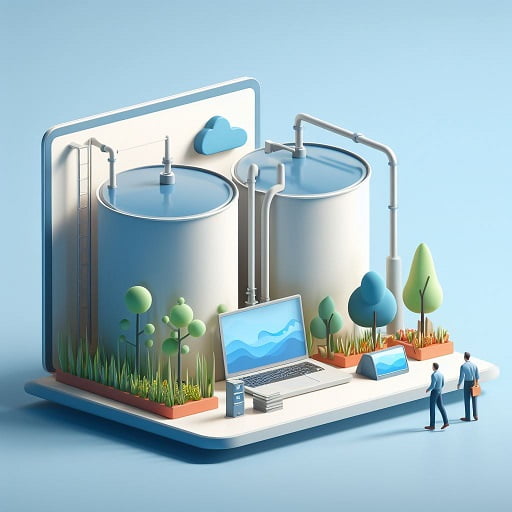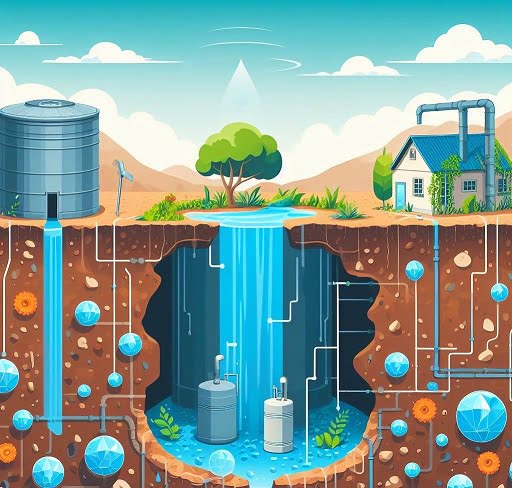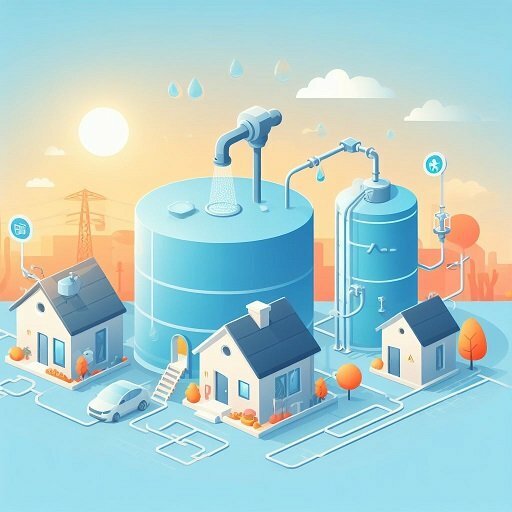Water is essential for life, but it is also a scarce and valuable resource. Water storage is a way of ensuring that we have enough water for our needs, whether it is for drinking, cooking, washing, gardening, or other purposes. Water storage also helps us cope with emergencies, such as droughts, floods, fires, or power outages.
The purpose of this article is to provide you with information about the different types of water storage tanks available in the market. Water storage tanks are containers that hold water for various uses. They come in different shapes, sizes, materials, and designs. Depending on your needs and preferences, you can choose the best water storage tank for your situation.
Types of Water Storage Tanks
There are three main types of water storage tanks: above-ground water storage tanks, underground water storage tanks, and rainwater harvesting tanks. Each type has its own advantages and disadvantages, as well as specific applications and usage.
Above-Ground Water Storage Tanks
Above-ground water storage tanks are the most common and visible type of water storage tanks. They are usually placed on the ground or on elevated platforms. They can be made of different materials, such as steel, fiberglass, or polyethylene.
Steel Tanks
Steel tanks are strong and durable water storage tanks that can withstand harsh weather conditions and corrosion. They are often coated with protective layers to prevent rusting and leakage. Steel tanks can store large volumes of water for long periods of time. They are suitable for industrial, agricultural, and municipal uses.
However, steel tanks are also heavy and expensive to install and maintain. They may require regular painting and inspection to prevent deterioration. Steel tanks may also affect the taste and quality of the water stored in them.
Fiberglass Tanks
Fiberglass tanks are lightweight and corrosion-resistant water storage tanks that can be molded into various shapes and sizes. They are easy to install and transport, and they do not require much maintenance. Fiberglass tanks can store potable and non-potable water for residential, commercial, and industrial uses.
However, fiberglass tanks are also fragile and prone to cracking or breaking under pressure or impact. They may not be able to withstand high temperatures or fire. Fiberglass tanks may also be more expensive than other types of water storage tanks.
Polyethylene Tanks
Polyethylene tanks are plastic water storage tanks that are flexible and resistant to chemicals and UV rays. They are cheap and easy to manufacture, install, and maintain. Polyethylene tanks can store potable and non-potable water for domestic, agricultural, and recreational uses.
However, polyethylene tanks are also susceptible to deformation and puncture under stress or sharp objects. They may not be able to handle high pressures or temperatures. Polyethylene tanks may also leach harmful substances into the water stored in them.
Underground Water Storage Tanks
Underground water storage tanks are water storage tanks that are buried underground or partially submerged in the ground. They can be made of different materials, such as concrete, plastic, or cisterns.
Concrete Tanks
Concrete tanks are sturdy and long-lasting water storage tanks that can withstand high pressures and loads. They are often reinforced with steel bars or wires to prevent cracking or collapsing. Concrete tanks can store large volumes of water for municipal, industrial, or agricultural uses.
However, concrete tanks are also heavy and difficult to install and repair. They may require excavation and foundation work to ensure stability and safety. Concrete tanks may also affect the pH level and quality of the water stored in them.
Plastic Tanks
Plastic tanks are similar to polyethylene tanks, but they are designed specifically for underground use. They are lightweight and corrosion-resistant water storage tanks that can be easily installed and maintained. Plastic tanks can store potable and non-potable water for residential, commercial, or industrial uses.
However, plastic tanks are also vulnerable to deformation and puncture under stress or sharp objects. They may not be able to handle high pressures or temperatures. Plastic tanks may also leach harmful substances into the water stored in them.
Cisterns
Cisterns are ancient types of water storage tanks that collect rainwater or groundwater from wells or springs. They are usually made of stone, brick, or concrete, and they have a simple design with an inlet pipe, an outlet pipe, and a cover. Cisterns can store potable or non-potable water for domestic or agricultural uses.
However, cisterns are also prone to contamination and evaporation due to exposure to the environment. They may require regular cleaning and disinfection to ensure the quality of the water stored in them. Cisterns may also have limited capacity and availability depending on the rainfall or groundwater level.
Rainwater Harvesting Tanks
Rainwater harvesting tanks are water storage tanks that collect rainwater from roofs or other surfaces using gutters, pipes, filters, and pumps. They can be made of different materials, such as barrels, drums, modular rainwater tanks, or bladder tanks.
Barrels and Drums
Barrels and drums are simple and inexpensive water storage tanks that can be made from recycled or new materials. They are usually placed near the downspouts of the roofs to collect rainwater. Barrels and drums can store small volumes of water for gardening, washing, or flushing toilets.
However, barrels and drums are also limited in capacity and functionality. They may not have proper lids or screens to prevent debris, insects, or animals from entering the water. Barrels and drums may also require manual filling and emptying to prevent overflow or stagnation.
Modular Rainwater Tanks
Modular rainwater tanks are water storage tanks that consist of multiple interconnected modules that can be arranged in different shapes and sizes. They are usually made of plastic or metal, and they have a sophisticated design with filters, pumps, valves, and sensors. Modular rainwater tanks can store large volumes of water for domestic, commercial, or industrial uses.
However, modular rainwater tanks are also complex and expensive to install and operate. They may require professional installation and maintenance to ensure optimal performance and safety. Modular rainwater tanks may also need electricity or backup power to run the pumps and sensors.
Bladder Tanks
Bladder tanks are water storage tanks that consist of flexible membranes that expand and contract with the water level. They are usually made of rubber or PVC, and they have a simple design with an inlet hose, an outlet hose, and a vent. Bladder tanks can store moderate volumes of water for residential, commercial, or recreational uses.
However, bladder tanks are also sensitive to puncture and abrasion under stress or sharp objects. They may not be able to handle high pressures or temperatures. Bladder tanks may also affect the taste and quality of the water stored in them.
Material Considerations
The material of the water storage tank is an important factor to consider when choosing the best type of water storage tank for your situation. Different materials have different advantages and disadvantages in terms of strength, durability, cost, maintenance, and impact on the water quality.
Steel Water Storage Tanks
Steel water storage tanks are made of steel sheets or plates that are welded or bolted together. Steel is a strong and durable material that can withstand harsh weather conditions and corrosion. Steel water storage tanks have the following advantages:
- They can store large volumes of water for long periods of time.
- They can handle high pressures and temperatures.
- They can be customized to fit different shapes and sizes.
- They can be recycled or reused.
However, steel water storage tanks also have the following disadvantages:
- They are heavy and expensive to install and maintain.
- They may require regular painting and inspection to prevent rusting and leakage.
- They may affect the taste and quality of the water stored in them.
Fiberglass Water Storage Tanks
Fiberglass water storage tanks are made of fiberglass strands that are woven together and coated with resin. Fiberglass is a lightweight and corrosion-resistant material that can be molded into various shapes and sizes. Fiberglass water storage tanks have the following advantages:
- They are easy to install and transport.
- They do not require much maintenance.
- They do not affect the taste and quality of the water stored in them.
However, fiberglass water storage tanks also have the following disadvantages:
- They are fragile and prone to cracking or breaking under pressure or impact.
- They may not be able to withstand high temperatures or fire.
- They may be more expensive than other types of water storage tanks.
Polyethylene Water Storage Tanks
Polyethylene water storage tanks are made of polyethylene plastic that is extruded or molded into various shapes and sizes. Polyethylene is a flexible and resistant material that can withstand chemicals and UV rays. Polyethylene water storage tanks have the following advantages:
- They are cheap and easy to manufacture, install, and maintain.
- They can be recycled or reused.
- They come in different colors and designs.
However, polyethylene water storage tanks also have the following disadvantages:
- They are susceptible to deformation and puncture under stress or sharp objects.
- They may not be able to handle high pressures or temperatures.
- They may leach harmful substances into the water stored in them.
Concrete Water Storage Tanks
Concrete water storage tanks are made of concrete that is poured into molds or forms. Concrete is a sturdy and long-lasting material that can withstand high pressures and loads. Concrete water storage tanks have the following advantages:
- They can store large volumes of water for municipal, industrial, or agricultural uses.
- They can be integrated into the landscape or architecture.
- They can be reinforced with steel bars or wires to prevent cracking or collapsing.
However, concrete water storage tanks also have the following disadvantages:
- They are heavy and difficult to install and repair.
- They may require excavation and foundation work to ensure stability and safety.
- They may affect the pH level and quality of the water stored in them.
Plastic Water Storage Tanks
Plastic water storage tanks are similar to polyethylene water storage tanks, but they are designed specifically for underground use. They are lightweight and corrosion-resistant water storage tanks that can be easily installed and maintained. Plastic water storage tanks have the following advantages:
- They are cheap and easy to manufacture, install, and maintain.
- They can be recycled or reused.
- They do not affect the taste and quality of the water stored in them.
However, plastic water storage tanks also have the following disadvantages:
- They are vulnerable to deformation and puncture under stress or sharp objects.
- They may not be able to handle high pressures or temperatures.
- They may leach harmful substances into the water stored in them.
Application and Usage
The application and usage of the water storage tank depend on the type, size, and location of the tank, as well as the water source and demand. Different types of water storage tanks have different applications and uses for residential, commercial, or agricultural purposes.
Residential Water Storage Tanks
Residential water storage tanks are water storage tanks that are used for domestic purposes, such as drinking, cooking, washing, or gardening. Residential water storage tanks can be above-ground or underground, depending on the space and preference of the homeowner. Residential water storage tanks can also be rainwater harvesting tanks that collect rainwater from the roofs or other surfaces.
The sizing and capacity of the residential water storage tank depend on the number of people in the household, the average water consumption per person, and the availability and reliability of the water supply. A general rule of thumb is to have a water storage tank that can hold at least three days’ worth of water for the household.
Some maintenance tips for residential water storage tanks are:
- Check the tank regularly for leaks, cracks, or damage.
- Clean the tank periodically to remove sediment, algae, or bacteria.
- Disinfect the tank with chlorine or other chemicals to kill any pathogens.
- Replace any worn-out parts or accessories, such as valves, hoses, or filters.
- Cover the tank with a lid or screen to prevent debris, insects, or animals from entering the water.
Commercial Water Storage Tanks
Commercial water storage tanks are water storage tanks that are used for business or industrial purposes, such as manufacturing, processing, cooling, heating, or firefighting. Commercial water storage tanks can be above-ground or underground, depending on the space and requirements of the business. Commercial water storage tanks can also be rainwater harvesting tanks that collect rainwater from roofs or other surfaces.
The industrial uses of commercial water storage tanks include:
- Storing raw materials or finished products that require water as an ingredient or a solvent.
- Providing water for cleaning, rinsing, or sanitizing equipment or machinery.
- Providing water for steam generation, power generation, or refrigeration.
- Providing water for chemical reactions, mixing, or dilution.
- Providing water for testing, quality control, or safety measures.
The commercial uses of commercial water storage tanks include:
- Storing potable water for drinking, cooking, or washing for employees or customers.
- Storing non-potable water for landscaping, irrigation, or flushing toilets.
- Storing rainwater for reducing stormwater runoff and saving on water bills.
- Storing firewater for emergency firefighting.
Agricultural Water Storage Tanks
Agricultural water storage tanks are water storage tanks that are used for farming or livestock purposes, such as irrigation, watering, or feeding. Agricultural water storage tanks can be above-ground or underground, depending on the space and need of the farm. Agricultural water storage tanks can also be rainwater harvesting tanks that collect rainwater from the roofs or other surfaces.
The farming and irrigation uses of agricultural water storage tanks include:
- Storing surface water or groundwater for watering crops or plants.
- Storing rainwater for supplementing irrigation systems or reducing groundwater depletion.
- Storing treated wastewater for reusing in irrigation or fertilization.
- Storing nutrient solutions for hydroponic farming.
The livestock watering uses of agricultural water storage tanks include:
- Storing potable water for drinking or washing for animals.
- Storing non-potable water for cooling or cleaning for animals.
- Storing rainwater for reducing dependence on wells or pumps.
Environmental Impact
The environmental impact of the water storage tank is another factor to consider when choosing the best type of water storage tank for your situation. Different types of water storage tanks have different impacts on the environment in terms of sustainability, recycling, and water conservation.
Sustainability of Water Storage Tanks
The sustainability of water storage tanks refers to how well they can meet the current and future water needs without compromising the natural resources or the ecosystem. The sustainability of water storage tanks depends on the material, design, and location of the tank, as well as the water source and demand.
Some examples of sustainable water storage tanks are:
- Steel water storage tanks that are made from recycled or reused steel and coated with eco-friendly paints or coatings.
- Fiberglass water storage tanks that are made from renewable or biodegradable fibers and resins.
- Polyethylene water storage tanks that are made from recycled or reused plastic and have a low carbon footprint.
- Concrete water storage tanks that are made from locally sourced or recycled materials and have a low embodied energy.
- Plastic water storage tanks that are made from recycled or reused plastic and have a low environmental impact.
- Rainwater harvesting tanks that collect rainwater from the roofs or other surfaces and reduce the reliance on municipal or groundwater sources.
Recycling and Disposal
The recycling and disposal of water storage tanks refer to how easily they can be reused, recycled, or disposed of at the end of their lifespan. The recycling and disposal of water storage tanks depend on the material, condition, and availability of the tank, as well as the local regulations and facilities.
Some examples of recyclable or disposable water storage tanks are:
- Steel water storage tanks that can be melted down and reused for making new steel products or structures.
- Fiberglass water storage tanks that can be shredded and reused for making new fiberglass products or materials.
- Polyethylene water storage tanks that can be melted down and reused for making new plastic products or materials.
- Concrete water storage tanks that can be crushed and reused for making new concrete products or materials.
- Plastic water storage tanks that can be melted down and reused for making new plastic products or materials.
- Rainwater harvesting tanks that can be cleaned and reused for storing other liquids or materials.
Impact on Water Conservation
The impact on water conservation refers to how much they can help save or reduce the use of water from other sources. The impact on water conservation depends on the type, size, and location of the tank, as well as the water source and demand.
Some examples of water-conserving water storage tanks are:
- Steel water storage tanks that can store large volumes of water for long periods of time and reduce the need for frequent refilling or pumping.
- Fiberglass water storage tanks that do not affect the taste and quality of the water stored in them and reduce the need for filtering or treating.
- Polyethylene water storage tanks that come in different colors and designs and reduce the evaporation or heat loss of the water stored in them.
- Concrete water storage tanks that can be integrated into the landscape or architecture and reduce the runoff or erosion of the soil.
- Plastic water storage tanks that do not affect the taste and quality of the water stored in them and reduce the need for filtering or treating.
- Rainwater harvesting tanks that collect rainwater from the roofs or other surfaces and reduce the use of municipal or groundwater sources.
Choosing the Right Water Storage Tank
Choosing the right water storage tank for your situation is not an easy task. There are many factors to consider, such as the location and space, the water quality, the durability, the cost, and the maintenance requirements of the tank. Here are some tips to help you make the best decision:
Factors to Consider
Location and Space
The location and space of the water storage tank are important factors to consider because they affect the type, size, and design of the tank. You need to consider the following questions:
- Where do you want to place the tank? Is it above-ground or underground?
- How much space do you have for the tank? Is it enough to accommodate the tank and its accessories?
- How accessible is the tank? Is it easy to install, fill, empty, or repair?
- How visible is the tank? Does it match the aesthetics of your surroundings?
Depending on your answers, you may choose a water storage tank that is suitable for your location and space. For example:
- If you want to place the tank above-ground and you have enough space and accessibility, you may choose a steel, fiberglass, or polyethylene tank that can store large volumes of water and handle high pressures and temperatures.
- If you want to place the tank underground and you have limited space and accessibility, you may choose a concrete, plastic, or cistern tank that can store moderate volumes of water and withstand high loads and pressures.
- If you want to place the tank near your roof or other surface and you have limited space and visibility, you may choose a barrel, drum, modular rainwater, or bladder tank that can store small volumes of water and collect rainwater.
Water Quality
The water quality of the water storage tank is another important factor to consider because it affects the health and safety of the users and the environment. You need to consider the following questions:
- What is the source of the water? Is it potable or non-potable?
- What is the purpose of the water? Is it for drinking, cooking, washing, or other uses?
- What are the contaminants or pollutants in the water? Are they biological, chemical, or physical?
- How do you treat or filter the water? What are the methods and devices you use?
Depending on your answers, you may choose a water storage tank that is suitable for your water quality. For example:
- If you want to store potable water for drinking, cooking, or washing, you may choose a fiberglass or polyethylene tank that does not affect the taste and quality of the water stored in them and does not leach harmful substances into the water.
- If you want to store non-potable water for landscaping, irrigation, or flushing toilets, you may choose a steel or concrete tank that can handle high pressures and temperatures and does not affect the pH level of the water stored in them.
- If you want to store rainwater for supplementing your water supply or reducing your water bills, you may choose a rainwater harvesting tank that can collect rainwater from your roofs or other surfaces and reduce your reliance on municipal or groundwater sources.
Durability
The durability of the water storage tank is another important factor to consider because it affects the lifespan and performance of the tank. You need to consider the following questions:
- How long do you want the tank to last? What is the expected lifespan of the tank?
- How well can the tank withstand the weather conditions and environmental factors? Is it resistant to corrosion, rust, cracking, or leakage?
- How often do you need to repair or replace the tank or its parts? What are the costs and difficulties involved?
Depending on your answers, you may choose a water storage tank that is suitable for your durability. For example:
- If you want a water storage tank that can last for decades or longer, you may choose a steel or concrete tank that is strong and durable and can withstand harsh weather conditions and corrosion.
- If you want a water storage tank that can last for years or shorter, you may choose a fiberglass or polyethylene tank that is lightweight and corrosion-resistant, and can be easily installed and maintained.
- If you want a water storage tank that can last for months or shorter, you may choose a plastic or bladder tank that is flexible and resistant and can be easily transported and replaced.
Cost Considerations
The cost of the water storage tank is another important factor to consider because it affects your budget and return on investment. You need to consider the following questions:
- How much do you want to spend on the tank? What is your budget range?
- How much do you need to pay for the installation and operation of the tank? What are the labor, material, and energy costs involved?
- How much do you need to pay for the maintenance and repair of the tank? What are the cleaning, disinfection, inspection, and replacement costs involved?
Depending on your answers, you may choose a water storage tank that is suitable for your cost. For example:
- If you want to spend more on the tank upfront but save on the long-term costs, you may choose a steel or concrete tank that has a high initial cost but a low maintenance and operation cost.
- If you want to spend less on the tank upfront but pay more on the long-term costs, you may choose a fiberglass or polyethylene tank that has a low initial cost but a high maintenance and operation cost.
- If you want to spend less on the tank overall but compromise on the quality and performance, you may choose a plastic or bladder tank that has a low initial and long-term cost but low durability and reliability.
Maintenance Requirements
The maintenance requirements of the water storage tank are another important factor to consider because they affect the quality and safety of the water stored in the tank. You need to consider the following questions:
- How easy or difficult is it to clean and disinfect the tank? What are the methods and devices you use?
- How often do you need to inspect and test the tank? What are the standards and procedures you follow?
- How easy or difficult is it to repair or replace the tank or its parts? What are the tools and skills you need?
Depending on your answers, you may choose a water storage tank that is suitable for your maintenance. For example:
- If you want a water storage tank that is easy to clean and disinfect, you may choose a fiberglass or polyethylene tank that does not affect the taste and quality of the water stored in it and does not require much maintenance.
- If you want a water storage tank that is easy to inspect and test, you may choose a steel or concrete tank that can handle high pressures and temperatures and has clear indicators of deterioration or damage.
- If you want a water storage tank that is easy to repair or replace, you may choose a plastic or bladder tank that is flexible and resistant and can be easily transported and replaced.
Installation and Safety
The installation and safety of the water storage tank are also important factors to consider when choosing the best type of water storage tank for your situation. Different types of water storage tanks have different installation guidelines and safety measures that need to be followed to ensure optimal performance and safety.
Proper Installation Guidelines
The proper installation guidelines for the water storage tank refer to how correctly and securely the tank is installed in its location. The proper installation guidelines depend on the type, size, and design of the tank, as well as the local regulations and permits.
Some examples of proper installation guidelines are:
- Steel water storage tanks should be installed on level ground or elevated platforms with adequate support and anchorage. They should also be coated with protective layers to prevent rusting and leakage.
- Fiberglass water storage tanks should be installed on level ground or elevated platforms with adequate support and clearance. They should also be protected from direct sunlight or heat sources to prevent cracking or breaking.
- Polyethylene water storage tanks should be installed on level ground or elevated platforms with adequate support and ventilation. They should also be protected from direct sunlight or heat sources to prevent deformation or puncture.
- Concrete water storage tanks should be installed underground or partially submerged in the ground with adequate excavation and foundation work. They should also be reinforced with steel bars or wires to prevent cracking or collapsing.
- Plastic water storage tanks should be installed underground or partially submerged in the ground with adequate excavation and foundation work. They should also be protected from direct sunlight or heat sources to prevent deformation or puncture.
- Rainwater harvesting tanks should be installed near the roofs or other surfaces with adequate gutters, pipes, filters, and pumps. They should also be covered with lids or screens to prevent debris, insects, or animals from entering the water.
Safety Measures
The safety measures of the water storage tank refer to how safely and securely the tank is operated and maintained in its location. The safety measures depend on the type, size, and design of the tank, as well as the local regulations and permits.
Some examples of safety measures are:
- Steel water storage tanks should be regularly painted and inspected to prevent rusting and leakage. They should also be equipped with pressure relief valves, vents, and gauges to prevent overpressure or explosion.
- Fiberglass water storage tanks should be regularly checked and repaired to prevent cracking or breaking. They should also be equipped with pressure relief valves, vents, and gauges to prevent overpressure or explosion.
- Polyethylene water storage tanks should be regularly cleaned and disinfected to prevent algae or bacteria growth. They should also be equipped with pressure relief valves, vents, and gauges to prevent overpressure or explosion.
- Concrete water storage tanks should be regularly cleaned and disinfected to prevent algae or bacteria growth. They should also be equipped with pressure relief valves, vents, and gauges to prevent overpressure or explosion.
- Plastic water storage tanks should be regularly cleaned and disinfected to prevent algae or bacteria growth. They should also be equipped with pressure relief valves, vents, and gauges to prevent overpressure or explosion.
- Rainwater harvesting tanks should be regularly cleaned and disinfected to ensure the quality of the water stored in them. They should also be equipped with filters, pumps, valves, and sensors to ensure optimal performance and safety.
Conclusion
Water storage tanks are containers that hold water for various uses. They come in different types, such as above-ground, underground, or rainwater harvesting tanks. They can also be made of different materials, such as steel, fiberglass, polyethylene, concrete, plastic, or cisterns.
Choosing the right water storage tank for your situation is not an easy task. You need to consider many factors, such as the location and space, the water quality, the durability, the cost, and the maintenance requirements of the tank. You also need to follow proper installation guidelines and safety measures to ensure optimal performance and safety.
Water storage tanks are not only useful for storing water for your needs, but they are also beneficial for the environment. They can help you save or reduce the use of water from other sources, recycle or reuse the water stored in them, and conserve natural resources and the ecosystem.
We hope this article has provided you with useful information about the different types of water storage tanks available in the market. We hope you can make the best choice for your situation and enjoy the benefits of having a water storage tank.




